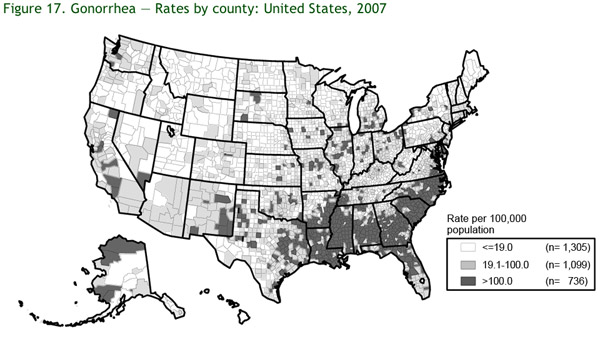
The expansion of sex ed in Chicago schools is not a bad thing, but this brought me up short:
Dr. Stephanie Whyte, chief health officer for Chicago Public Schools, presented statistics showing that Cook County ranks first nationally for rates of gonorrhea and syphilis among all counties and second in Chlamydia.
Not sure what data she's got; that's not exactly what the current CDC data say. Cook County has the most total cases of gonorrhea of any county in America—which isn't good, considering it's the second-biggest county. But it doesn't have the highest rates of infection. Not by a long shot. Our rate in 2011 was 209.1 cases per 100,000. (Update: My colleage @emmetds notes that gonorrhea is curable, but the emergence of drug-resistant gonorrhea is worrisome. JAMA has more on how it's conquered several different antibiotic agents in the past, and resistance is increasing against cephalosporin.)
By comparision, here are the counties with the highest incidence rates:
- Caddo, Louisiana: 614.6
- St. Louis, Missouri: 611.3
- Montgomery, Alabama: 509.7
- Orleans, Louisiana: 499.7
- Cumberland, North Carolina: 471.8
- Hinds, Mississippi: 455.0
- Philadelphia, Pennsylvania: 443.1
And so forth. Cook County's pretty far down on the list. The counties with the highest rates tend to cluster geographically.

There's significant geographical variance in Chicago as well. The disease tends to cluster in certain areas. Using data from the city's data portal, I mapped the rates per 100,000 people. The data is reported for men and women separately, so the final number is an average of the two. And not all community areas have reported data. But look at how drastic the difference from one part of town to another–the infection rates range from a low of 71.7 in Lincoln Park to 2,654 in West Englewood.
The good news, if there is any? The disease is curable. Here's a quick look at how to know if you're already infected.


